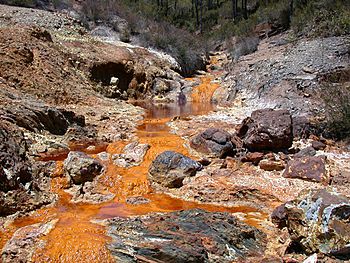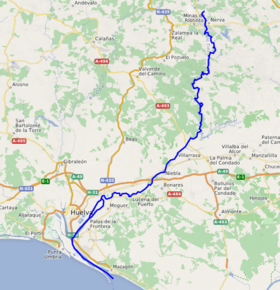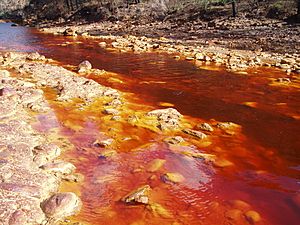Rio Tinto (river) facts for kids
Quick facts for kids Río Tinto |
|
|---|---|

Rio Tinto
|
|

Course of the Rio Tinto
|
|
| Other name(s) | Tinto River |
| Country | Spain |
| Region | Andalusia |
| Physical characteristics | |
| Main source | Sierra Morena Andalusia |
| River mouth | Gulf of Cádiz 37°12′36″N 6°56′17″W / 37.21°N 6.938°W |
| Length | 100 km (62 mi) |
The Río Tinto (which means "Red River" in Spanish) is a unique river in southwestern Spain. It starts in the Sierra Morena mountains in Andalusia and flows towards the Gulf of Cádiz near Huelva.
What makes the Río Tinto special is its bright red and orange color. This color comes from its unusual chemical makeup. The water is very acidic and has high levels of iron and other heavy metals dissolved in it.
The river keeps its strong color for about 50 kilometers (31 miles). After this point, near a town called Niebla, its chemistry starts to change. This happens because the Río Tinto mixes with other streams that connect to the Atlantic Ocean. The river is about 100 km (62 mi) (62 miles) long. It flows through an area known as the Iberian Pyrite Belt, which has many ore and sulfide deposits.
Mining History of the Río Tinto
The area around the Río Tinto has been a place for mining for about 5,000 years! People have dug for copper, silver, gold, and other minerals. These mines were sometimes as far as 20 kilometers (12 miles) from the river itself.
This long history of mining is likely why the Río Tinto is so acidic. Its pH level is around 2, which is very low (like lemon juice). The deep reddish color comes from the iron that has dissolved into the water. Water draining from the mines, called acid mine drainage, causes serious environmental problems. This is because the low acidity dissolves heavy metals into the water. Scientists are still studying how much of this acidity is natural and how much is from mining.
Mining in this region began around 3000 BC with groups like the Tartessans and Iberians. Later, the Phoenicians, Greeks, Romans, Visigoths, and Moors also mined here. They mostly looked for copper, silver, and gold. Over time, they also mined for iron and manganese. All this mining has greatly changed the landscape of the area.
After a period when the mines were not used, they were rediscovered in 1556. The Spanish government started operating them again in 1724. In the 1800s, companies from the United Kingdom began large-scale mining. The Rio Tinto Company was formed in 1873 to run the mines. Production slowed down after 1930, and copper mining stopped in 1986. Silver and gold mining ended in 1996, and all mining in the area stopped in 2001.
In the 2010s, copper prices went up, and a company called EMED Mining tried to reopen the mine. However, they faced challenges getting all the land rights and environmental approvals. The mine, which once employed up to 20,000 people, would have started with about 350 workers. A big concern was whether old water reservoirs could handle new waste from mining.
Life in the Red River
Even though the Río Tinto is a very harsh place, some tiny living things can survive there! These are called extremophiles. Extremophiles are microorganisms that love extreme conditions. In the Río Tinto, you can find certain types of bacteria, algae, and other tiny organisms called heterotrophs.
Scientists are very interested in this river because of these extremophiles. The rocks under the river contain iron and sulfide minerals, which the bacteria eat. The extreme conditions in the Río Tinto might be similar to places on other planets or moons in our Solar System that could have liquid water.
For example, scientists have compared the water chemistry of the Río Tinto to the conditions where rocks on Mars were formed. They also think that Europa, one of Jupiter's moons, might have an acidic ocean under its icy surface. By studying the Río Tinto, astrobiologists (scientists who study life in space) can learn about the limits of where life can exist and what makes a planet able to support life.
See also
 In Spanish: Río Tinto para niños
In Spanish: Río Tinto para niños
- Acid mine drainage
- Environmental effects of mining
- List of rivers of Spain
- Tourist Mining Train


